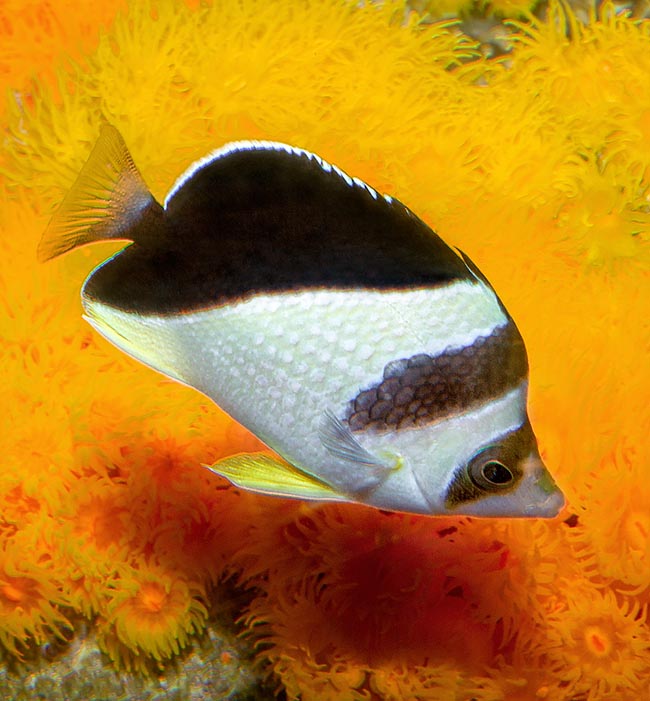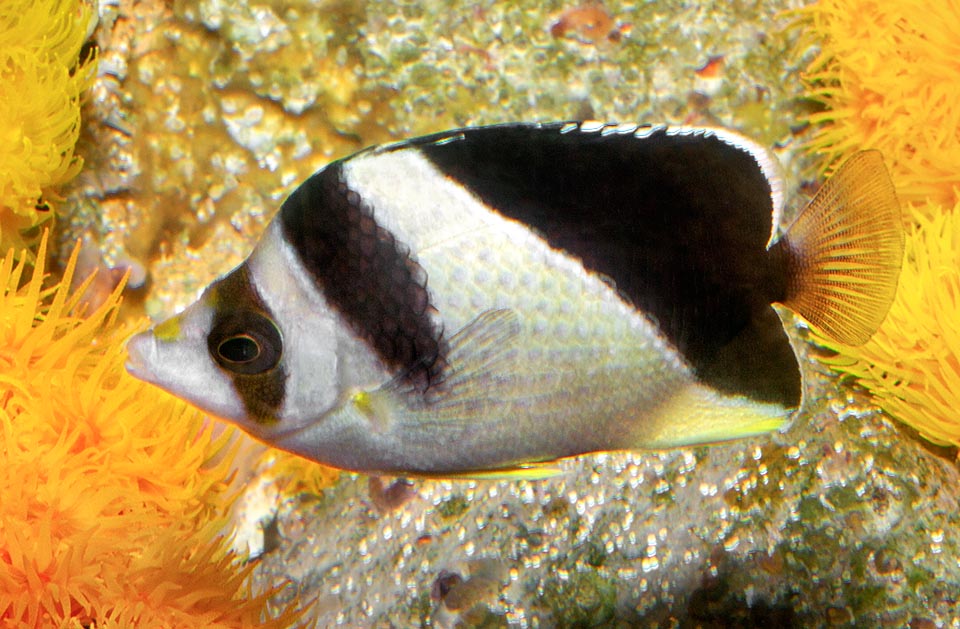Family : Chaetodontidae

Text © Giuseppe Mazza

English translation by Mario Beltramini
The Burgess’ butterflyfish (Chaetodon burgessi Allen & Starck, 1973) belongs to the class of the Actinopterygii, the ray-finned fishes, to the order of the Perciformes and to the picturesque family of the Chaetodontidae that guests the butterfly fishes.
The name of the genus Chaetodon comes from the Greek “χαίτη” (khaite) = hair and “ὀδούς” (odous) = tooth, due to the teeth shaped like bristles, whilst that of the species, burgessi, in Latin “of Burgess”, is honouring the American ichthyologist Warren E. Burgess, author, inter alia, of a monograph concerning the butterfly fishes.
Zoogeography
The Chaetodon burgessi is a species of tropical Indo Pacific. We find it in Malaysia, Indonesia, and Philippines, and then, proceeding eastwards, in the Palau islands, in Papua New Guinea, Micronesia and Tonga islands.

Like Chaetodon mitratus, to which resembles, the Chaetodon burgessi swims in relatively deep waters for a butterflyfish, up to about 80 m on the reefs outer cliffs, among gorgonians and black corals © Giuseppe Mazza
Ecology-Habitat
Like the Chaetodon mitratus, to whom it looks like, it swims in waters relatively deep for a butterfly fish, between 20 and 80 m of depth, on the outer cliffs of the reefs, among the gorgonians and the black corals.
Morphophysiology
Burgess’ butterflyfish measures less than 14 cm.
The body is flattened laterally with high back, as normal among the Chaetodon, but with an unusual profile, also because of the diagonal dark pattern.
The background colour is whitish and, excluding the pelvic fins, the yellow shades are rare. Furthermore, compared to the Chaetodon mitratus, the three dark bands have a quite different consistency. The first one, the vertical that camouflages the eye, is similar, but the second one appears remarkably reduced, whilst the third, on the contrary, is much wider, interesting besides the body almost all the dorsal fin and most of the anal one.
This last dark band, inter alia, is practically the same of that of the Hawaiian butterflyfish (Chaetodon tinkeri) and seen that in some populations of Chaetodon burgessi the band that camouflages the eye is orange with black edge as in the Hawaiian fish, some evoke a close relatinship between the two species.
The snout is longer and more pointed than Chaetodon mitratus, and the mouth, also protractile, has as always tiny teeth similar to brushes on both jaws.
The dorsal fin, erectile when the fish feels menaced and cannot avoid the importunate, bears 13 spiny rays and 18-19 soft; the anal 3 spiny rays and 15-16 unarmed; the pectoral and the pelvic ones are unarmed; the caudal is more or less truncated.
Ethology-Reproductive Biology
The Burgess’ butterflyfish nourishes of small benthic invertebrates it finds rummaging in the fissures of the rocks or between the corals. It lives isolated or in couple, which seem lasting, that take form during the reproductive period.

Hybrids exist between Chaetodon burgessi and Chaetodon flavocoronatus, that for some shoud be also coming from the union of Chaetodon burgessi with Chaetodon tinkeri © Giuseppe Mazza
The mating occurs in mid-water, while swimming, and the eggs, fecundated in the flight by the male, are entrusted to the currents. They hatch on the following day. The pelagic larvae go adrift and the small fishes often reach the bottoms very far away from the place where they were born.
To the delight of the ichthyologists, hybrids have been found, and this is not astonishing seen the modalities of mating, between Chaetodon burgessi and Chaetodon flavocoronatus, others finally argue that the Chaetodon flavocoronatus should have been in its turn generated from the union, in distant times, between Chaetodon burgessi and Chaetodon tinkeri.
Much less expensive than the Chaetodon mitratus and equally easy to feed, the Chaetodon burgessi is very much required by the aquarium market and regularly exported to Philippines.
However there is no risk for the populations, seen that they may double in less than 15 months. The vulnerability index of the species is nowadays (2020) very low, marking only 12 on a scale of 100.
→ For general information about FISH please click here.
→ For general information about BONY FISH please click here
→ For general information about CARTILAGINOUS FISH please click here.
→ To appreciate the BIODIVERSITY of BONY FISH please click here.
→ To appreciate the BIODIVERSITY of CARTILAGINOUS FISH please click here.
